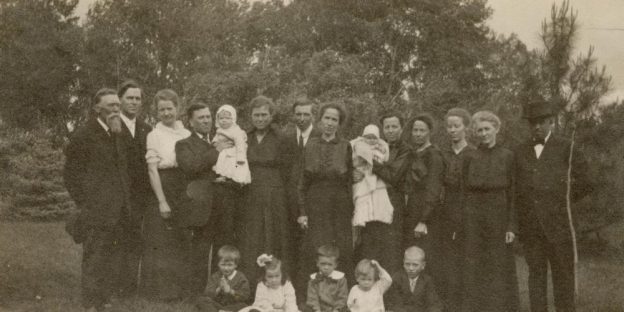Tracing Pioneer Routes
The Berdahls joined with other Norwegian families in 1863 to form a caravan of eleven covered wagons that moved from Fillmore County in Minnesota to Dakota Territory. In June of that year, they arrived at a location near what is now Garretson, South Dakota, in Minnehaha County. Their four-week trek across southern Minnesota followed approximately the route that Per Hansa’s family takes in Giants in the Earth.
Leaving Fillmore County
“The John E. Berdahl family consisting of Mr. and Mrs. Berdahl, their sons, Andrew and Erick and his wife (they were just married), and Anfin, Ole, Herman, John, Christoffer and daughters, Christie and Martha. With them were Aunt Synneva and C. O. Henjum. They had 3 covered wagons, 2 horse-teams and 1 ox-team. These all started from Amherst township, Fillmore county, and camped the first night near the southwestern corner of the county.”
Andrew Berdahl, “Berdahl autobiography,” page 7-8
Onward to Mower County
“Thence west into Mower county towards Adams where we camped for a day or more waiting for the following from near Calmar, Iowa, who were to join us there.
Thor Hermanson and wife with their daughters… with one covered wagon and ox team. And grandfather Herman Wansness and wife with their youngest son… They also had 1 covered wagon and ox team.
After they joined us there we were a caravan of 10 covered wagons with 5 horse-teams and 5 ox-teams. Together we had a herd of 85 head of cattle, 8 colts and 30 sheep to drive. The first few days out from home it gave all our young boys and girls plenty of exercise to keep all this big herd together and to follow the caravan of wagons. But after the first week or so, and after coming out of the timbered country into more open prairie there was no trouble. The cattle- cows especially- would come along just as soon as they saw the wagons move. Some boys would ride some of the older colts and round up dilatory colts and sheep, and the youngsters had lots of fun.
From home we brought with us a large tent which we set up every night where we camped. This gave a lot of the youngsters sleeping quarters. Brother Erick and I who had been over the road twice naturally had to take the lead and decide on places to camp at night. Father had gone on some time before by train and other transportation to build some sort of habitation for the family.
This was a very wet season. Heavy rains every week, so that all sloughs and creeks were overflowing. To detour around sloughs, and often setting mired even so bad sometimes that we had to unload to get wagons pulled out, made our progress very slow.”
-Andrew Berdahl, “Berdahl autobiography,” page 7-8
Slip Up Creek
“Of course they have–somewhere near, at any rate. There’s supposed to be a creek around here, by the name of Split Rock Creek, or whatever they call it in English.
Now he got up, walking erectly with a confident step, like a man who has just made a lucky strike, and began to search along the whole slope. . . . He might as well go ahead and find the ford to-night; then he wouldn’t be delayed by hunting for it in the morning. The underbrush thickened as he made his way down the slope. . . . Here, then, was Split Rock Creek; and here they had camped, as Tönseten had said they would! . . .” (Giants in the Earth, page 12)
Ole Rølvaag, “Giants in the Earth,” page 12

